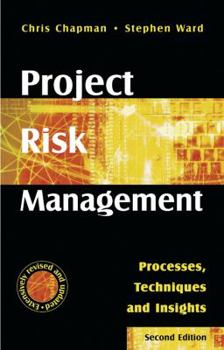Project Risk Management: Processes, Techniques and Insights
Select Format
Select Condition 
Book Overview
Based on sound conceptual foundations yet developed to meet practical concerns, Project Risk Management has become recognized as a standard work on its subject. It sets out the key issues and concepts... This description may be from another edition of this product.
Format:Hardcover
Language:English
ISBN:0470853557
ISBN13:9780470853559
Release Date:December 2003
Publisher:Wiley
Length:389 Pages
Weight:1.40 lbs.
Dimensions:1.1" x 6.8" x 10.1"
Related Subjects
Business Business & Finance Business & Investing Economics Engineering Entrepreneurship Industrial Industrial Engineering Industrial, Manufacturing & Operational Systems Management Management & Leadership Production & Operations Project Management Small Business & Entrepreneurship Total Quality ManagementCustomer Reviews
3 ratings
I bought it 3 years ago and I still use it for my professional guidance
Published by Thriftbooks.com User , 15 years ago
As project risk management is a daunting factor to mitigate failures in software engineering, I bought this book to learn ways to mitigate risks in project management by using techniques presented in this book. As a veteran in software engineering field and have been leading critical projects, I still use it as a good tool to learn and adopt suggestions and techniques from the book in my professional career. I strongly recommend for project managers and technical leads in software and automation development.
Excellent Literature on Risk Management
Published by Thriftbooks.com User , 16 years ago
All projects involve risk and risk involves both threat and opportunity. In today's world of project management, perhaps the single most important skill that a project manager can possess is risk management. Organizations that better understand the nature of the risks can manage them more effectively. This book provides a framework for integrating risk management into the management of projects. It explains how to do this through the definition of generic risk management processes and shows how these processes can be mapped onto the stages of the project life cycle. Another feature is the risk management processes provided can be used for either project or product management because of the fine granularity of the project life cycle used - instead of the typical 6-stage Requirements, Design, Build, Test, Implement and Operate stages the authors use an 8-stage project life cycle that begins with conception and includes post-planning allocation and post-delivery review milestones. Moreover, the typical risk management cycle of Identify, Analyze and Quantify, Prioritize and Manage is expanded into a much more detailed cycle that includes focusing, clarifying ownership issues, and scenario analysis. In particular, the scenario analysis sub process is an excellent approach and allows going well beyond the typical expected monetary value and probability & impact types of analyses. The authors have set main emphasis on processes rather than analytical techniques. This book provides the reader with a fundamental understanding of project risk management processes but avoids being over prescriptive in the description of the execution of these processes. Instead, there is positive encouragement to use these generic processes as a starting point for elaboration and adaptation to suit the circumstances of a particular application, to innovate and experiment, to simplify and streamline the practical implementation of the generic processes to achieve cost-effective and efficient risk management. The Authors have made good comparisons between their work and both PRAM and RAMP, as well as with the Project Management Institute's PMBOK 2000. They have developed and named the generic framework SHAMPU (Shape, Harness, and Manage Project Uncertainty) process and compare it with PRAM, RAMP, and PMBOK 2000. The notion of risk efficiency is central to the theme. All risk management processes consume valuable resources and can themselves constitute a risk to the project that must be effectively managed. The level of investment in risk management within project must be challenged and justified on the level of expected benefit to the overall project. The Authors document numerous examples drawn from real project experience to substantiate the benefits of a formal process-oriented approach. Ultimately, project risk management is about people making decisions to try to optimize the outcome, being proactive in evaluating risk and the possible responses, using this infor
Heavy on process and insight; light on technique
Published by Thriftbooks.com User , 22 years ago
This is the most comprehensive treatment of project risk management processes I have read. The focus is on the process itself, using techniques to illustrate the advice and insights that are heavily interspersed throughout. Because techniques are used to reinforce the information on process and insights this book is better suited for readers who have a good understanding of risk management techniques.Another feature is the risk management processes provided can be used for either project or product management because of the fine granularity of the project life cycle used - instead of the typical 6-stage Requirements, Design, Build, Test, Implement and Operate stages the authors use an 8-stage project life cycle that begins with conception and includes post-planning allocation and post-delivery review milestones. Moreover, the typical risk management cycle of Identify, Analyze and Quantify, Prioritize and Manage is expanded into a much more detailed cycle that includes focusing, clarifying ownership issues, and scenario analysis. In particular, the scenario analysis sub process is an excellent approach and allows you to go well beyond the typical expected monetary value and probability x impact types of analyses. The authors assume that you have a good grounding in both probability and fundamental quantitative analysis techniques, and while both probability and a variety of techniques are used as examples they are only superficially explained. The best part of the book, though, is the large number of insights imparted through cases and real-life situations. These are thought-provoking, but require careful reading (especially for American readers who may not be used to the norms of the British vernacular).If you are interested in a mature project or product risk management process and have some background in risk management this is a five-star book that absolutely should be in your library.





